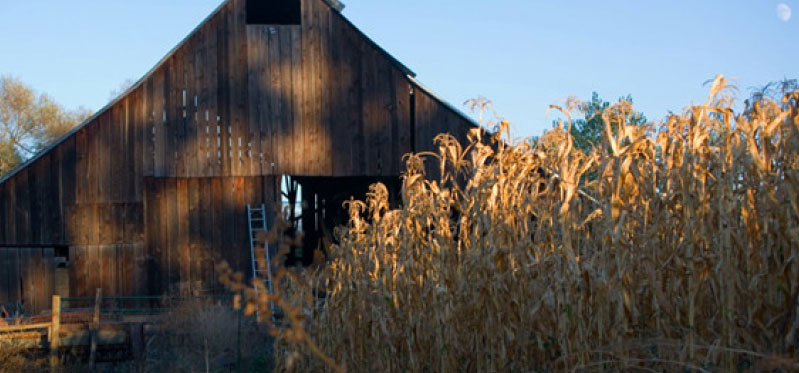August 1st marked Lammas, an Angelo-Saxon festival of first fruits, marked by the harvest of wheat and the baking of it into bread to be blessed and eaten by friends. Coincidentally (or well though out by Steve, you can decide) Live Power harvested its grain crops of barley, wheat, and rye the the day before and had the chance to, apprentices and all, take the harvest down to the Men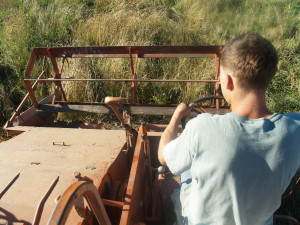 docino Grain Project granary in Ukiah. Doug Mosel, founder of Mendocino Grain Project, along with his apprentice Mai, showed us the grain cleaning equipment and procedures in cleaning the grain.
docino Grain Project granary in Ukiah. Doug Mosel, founder of Mendocino Grain Project, along with his apprentice Mai, showed us the grain cleaning equipment and procedures in cleaning the grain.
Steve and his sons, with the help of some apprentices, harvested the grain with a combine on the farm. This machine cuts the flower heads off the plants and threshes what it cuts, separating the grain from the straw and other bigger material. You can imagine doing this by hand, even on the two acres of grain we sowed. Scything the grain, gathering and tying it into bundles to be propped back upright in its bundle to let the grain ripen, and after a couple of days gathering hundreds of bundles to a hand-foot-or hydro propelled thresher. What took about three to four hours here would be increased to days and weeks, which nevertheless this writer can still dream about doing. Even with the combine, the grain that has been threshed and separated from all larger plant material still contains smaller plant material, from weeds and the husks covering the grain, that we don’t want mixed in. Such plant material can rot, when stored causing fungus and mold to crop up in with the grain. Not to speak of the extra work and worry it causes the poor baker (and eater!) who wants a consistent taste in his bread. Here is where the grain cleaning comes in.
To separate the grain from the other material mixed in, Doug Mosel took the grain through his seed cleaner. This machine cleans the grain by filtering it through screens, shaking, and blowing air through the compartment the grain passes through. Doug picked a filter for the obvious bigger material and two more for the smaller a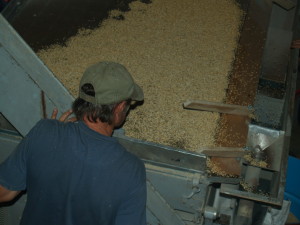 nd similar shaped morning glory seeds. The chaff and plant material was separated out, which we collected for animal feed, while the clean grain was siphoned in to a barrel. How beautiful it was to see pound and pound of grain fall into a couple of 50 gallon drums!
nd similar shaped morning glory seeds. The chaff and plant material was separated out, which we collected for animal feed, while the clean grain was siphoned in to a barrel. How beautiful it was to see pound and pound of grain fall into a couple of 50 gallon drums!
After a run through the seed cleaner, because there was still the similar shaped morning glory seeds mixed in, Doug next took the grain through a machine called a gravity table. Whereas the seed cleaner cleaned the seed, basically winnowing it, by motion, air, and different filters (discriminating by size), the gravity table used motion, air, and gravity. The heaver grain would outweigh the morning glory seed and would be separated by its weight rather than its size. Additionally, the heaver grain was separated from the lighter grain, giving us good seed to plant again next year, and hopefully in creasing the quality of grain grown through future plantings. Over all we cleaned only our wheat and rye crops which, wheat alone, weighed over 600 pounds.
Now we at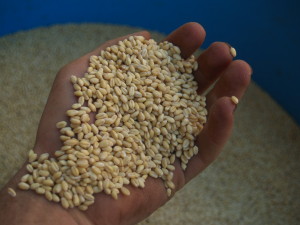 the farm can only wait for the delicious bread baked by Alexander in the brick oven! And such bread is one of the many examples of how rich a harvest small grain production can produce. You have not tasted bread until you have tasted wheat freshly harvested, milled, and baked in a brick oven the next day. How different the wheat that’s been milled and left to sit in bags for who knows how long (much less refined and bleached!) which further lacks the nutrients that are present in fresh kernels of grain. There is a reason why grain has existed alongside man for thousands of years which, when cooked and treated properly, is a good source of fiber, protein, carbohydrates, and other balancing nutrients.
the farm can only wait for the delicious bread baked by Alexander in the brick oven! And such bread is one of the many examples of how rich a harvest small grain production can produce. You have not tasted bread until you have tasted wheat freshly harvested, milled, and baked in a brick oven the next day. How different the wheat that’s been milled and left to sit in bags for who knows how long (much less refined and bleached!) which further lacks the nutrients that are present in fresh kernels of grain. There is a reason why grain has existed alongside man for thousands of years which, when cooked and treated properly, is a good source of fiber, protein, carbohydrates, and other balancing nutrients.
There is such a potential, once had – and now returning with endeavors like the Mendocino Grain Project – in this country, where grain is grown specifically for the locality it was grown in. Potential showing the different varieties, tastes and ways of cooking the grain; linking the present season with those of the past, through the seed and varieties passed down through generations; and on into the future, building a culture rich in what sustains and gives life to culture and the humans composing it. There is such a potential, once had and now returning, in practicing again an agriculture, where culture is tended and brought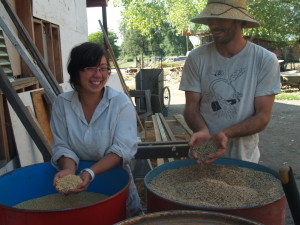 to life in its variety and rhythm along with the crop; where food is grown, cared for, and cultivated along with the human life surrounding.
to life in its variety and rhythm along with the crop; where food is grown, cared for, and cultivated along with the human life surrounding.
Is it any wonder the Egyptians placed their afterlife, their paradise in fields swollen in grain, and saw the divine in the agricultural flow of seasons? From the deep ocean-hued blue-green shoots rising to meet the Spring sun. The oscillating fields of “dazzling silver, emerald, fawn,” moved by the inhalations, the exhalations of the Spirit’s breath upon this world. The deepening crimsons and clay spotted ripening flower at top of a now weight burdened stem, of the fields, the fields of the amber waves of grain! The promise of the midsummer’s declining sun, the promise of harvest and plenty and bread crafted by the hands of one who knows of Love in the labor and gift of a Mother, crafted by the hands of who loves her. In the words of Walt Whitman:
Shot gold, maroon and violet, dazzling silver, emerald, fawn,
The earth’s whole amplitude and Nature’s multiform power consign’d for once to colors,
The light, the general air possess’d by them — colors till now unknown
To limit, confine — not the Western sky alone — the high meridian — North, South, all,
Pure luminous color fighting the silent shadows to the last.
If you’d like to learn more about harvesting grain and how you can get involved with other small grain farmers, please visit MendocinoGrain.net


